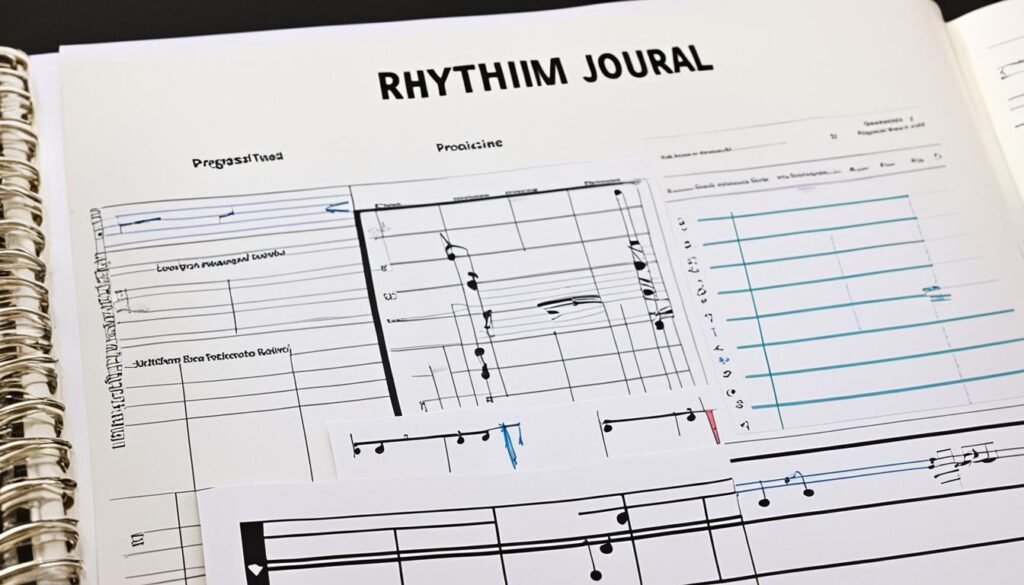Rhythm Tips is the core of music, the base of your musical skills. It’s vital for playing with confidence and feeling. This article will explore rhythm and share tips from top musicians to improve your skills.
Rhythm is what keeps music alive and in sync. It makes you want to move and groove. By learning about rhythm and practicing, you can improve your musical abilities and connect with the song’s rhythm.
Key Takeaways
- Rhythm is the foundation of all music, crucial for playing with confidence and precision.
- Developing a strong sense of rhythm involves understanding its components and incorporating targeted practice techniques.
- Mastering rhythm can help you connect more deeply with the groove and feel of a song.
- Expert tips from accomplished musicians can provide valuable insights to improve your rhythmic abilities.
- Regular practice and a focus on timing, groove, and rhythmic patterns can lead to significant progress in your musicianship.
The Essence of Rhythm in Music
Rhythm is the core of music, making it move and groove. It’s what makes you want to tap your foot or nod your head. Rhythm is key to music, helping musicians improve their skills and express themselves.
Why Rhythm Matters in Music
Rhythm is the foundation of music. It sets the timing and feel of a song. It helps musicians play together and perform with energy.
Whether it’s rock, jazz, or classical, rhythm makes music come alive. It grabs the listener’s attention.
Understanding Rhythm and Its Components
Rhythm is the pattern of sound from varying note lengths. It includes tempo and time signature. These elements are crucial for rhythm skills.
Also Read : Exploring The Boundaries Of Music Copyright
Learning different rhythmic patterns is key. It helps develop a strong sense of timing and rhythm.
| Rhythmic Component | Description |
|---|---|
| Tempo | The speed or pace of the music, measured in beats per minute (BPM) |
| Time Signature | The underlying rhythmic structure, indicated by a numerical fraction (e.g., 4/4, 3/4, 6/8) |
| Rhythmic Patterns | The varying durations of notes and rests, such as quarter notes, eighth notes, and triplets |
Knowing the importance of rhythm helps musicians develop a good sense of rhythm. It improves their ability to feel the beat and tap their foot. This boosts their musical skills and performance.
Rhythm Tips: Establishing a Solid Foundation
To become a skilled musician, mastering the basics of rhythm is key. Developing a strong sense of timing and learning basic rhythmic patterns is crucial. This sets the stage for more complex rhythms and helps you feel the groove naturally.
Developing a Sense of Timing
Getting a solid rhythmic foundation starts with feeling the beat. Using a metronome is a great way to improve your timing. Begin by tapping your foot or clapping along with the metronome. Then, increase the tempo to make it harder and sharpen your timing skills.
Mastering Basic Rhythmic Patterns
It’s also important to get good at reading and playing basic rhythmic patterns. Try clapping and counting exercises to improve your rhythmic reading skills. Get to know common patterns like quarter notes, eighth notes, and sixteenth notes. Practice using them in different songs.
Also Read : Exploring The Premier Music Colleges For Career Advancement
- Clap and count simple rhythms, gradually increasing the complexity
- Practice tapping out basic rhythmic patterns with your hands or feet
- Experiment with different rhythmic patterns and time signatures to expand your rhythmic vocabulary
Mastering these basic rhythmic skills builds a strong foundation for your music journey. It lets you confidently tackle complex rhythms and develop a great rhythm that wows your audience.
Incorporating Rhythm Exercises into Practice
Improving your rhythm skills is key to becoming a great musician. To get better at timing and rhythm, add specific exercises to your practice. Clapping and counting rhythms, along with metronome drills, are great techniques to use.
Clapping and Counting Rhythms
Clapping and counting rhythms are basic but powerful ways to boost your rhythm. You clap and say the rhythm out loud. This helps you feel the music’s beat and groove, making your rhythm skills better.
Metronome-Based Drills
Using a metronome is another effective way to improve your rhythm. With metronome drills, you play or clap to a steady beat. This builds rhythmic precision and consistency, helping you sync with the tempo.
By tapping your foot or strumming with the metronome, you’ll get the rhythm into your body. This makes your rhythm practice more effective.
Adding these exercises to your daily practice will make you more confident in your timing and rhythm. Remember, regular practice focused on rhythm is crucial for mastering any song.
Also Read : Insider Tips On Music University Scholarships For International Students
Rhythm Tips: Advancing Your Skills
As you get better at rhythm, it’s time for more challenging exercises. These exercises focus on syncopation and off-beat rhythms. Syncopation adds an exciting twist to music by emphasizing weak beats. Practicing these rhythms will improve your sense of groove and ability to play complex rhythms.
Syncopation and Off-Beat Exercises
Learning syncopation is key to improving your rhythm skills. Begin with simple rhythms like dotted quarter-eighth notes or quarter-eighth-quarter notes. Then, add more complex off-beat accents and rhythmic patterns.
- Clap or tap simple syncopated rhythms, focusing on precisely placing the emphasis on the off-beats.
- Practice playing syncopated rhythms along with a metronome or drum track, ensuring you maintain a solid sense of timing.
- Experiment with different rhythmic patterns, such as triplets or quintuplets, to challenge your rhythmic flexibility.
Working on syncopation and off-beat exercises will deepen your understanding of rhythm. You’ll learn to play with a unique groove. This skill will enhance your timing, feel, and musicality.
Also Read : How Music University Enhances Academic And Creative Growth
“Rhythm is the essential element of music. It’s what gives music its sense of movement. It’s the heartbeat, the driving force behind every song.”
Improving your rhythm skills is a continuous journey. Keep exploring and challenging yourself with new exercises. This will help you become a more versatile musician.
Rhythm Tips: Integrating Music Theory

Mastering rhythm exercises is key, but adding music theory knowledge boosts your skills. Knowing the basics of time signatures helps you understand a piece’s feel and structure. Learning to read rhythmic notation, like note values and time signatures, improves your ability to tackle complex rhythms.
Understanding Time Signatures
Time signatures tell us the rhythm and structure of music. Knowing simple ones like 4/4, 3/4, and 6/8 helps you grasp the beat’s organization. Exploring various time signatures lets you recognize and internalize complex rhythms. This way, you can learn to play with more precision and feeling.
Also Read : Why Every School Needs A Vibrant Music Education Program
Grasping Rhythmic Notation
Getting familiar with rhythmic notation, including note values and rests, deepens your rhythm understanding. Knowing how to read different note lengths, like whole, half, quarter, and eighth notes, improves your timing. Practicing sight-reading and analyzing your favorite songs’ rhythms builds a strong sense of timing and rhythm.
| Note Value | Duration | Symbol |
|---|---|---|
| Whole Note | 4 beats | ♫ |
| Half Note | 2 beats | ♩ |
| Quarter Note | 1 beat | ♪ |
| Eighth Note | 1/2 beat | ♪♪ |
Combining rhythm exercises with music theory deepens your rhythmic skills. This approach enhances your musical abilities and rhythm practice.
“Rhythm is the essential element of music. Without a strong sense of rhythm, a musician cannot truly feel the beat and tap your foot to the music.”
Building Rhythmic Memory and Transcription
As a musician, it’s key to have a strong rhythmic memory and the skill to transcribe rhythms. By practicing rhythmic exercises and listening to music’s rhythms, you train your brain. This skill boosts your performance and helps you learn new music easily.
Rhythm practice is a great way to improve your memory. Clap or tap along with a metronome, practice patterns, and transcribe your favorite songs. Doing these activities often helps you develop a strong sense of timing and rhythm. It makes it easier to feel the beat and sync with the song’s rhythms.
Transcription is also important for building rhythmic memory. Listen to and analyze the rhythmic patterns in music to train your brain. This skill is useful when learning new songs or getting into the rhythm of a song. With practice, you’ll see your rhythmic skills improve greatly.
Remember, rhythm is one of the most basic but important parts of music. Spending time on rhythm practice and transcription will boost your musical skills. It will also deepen your understanding and love for the rhythm and beat in every great song.
Rhythm Tips: Exploring Different Genres

Exploring various genres can boost your rhythmic skills and introduce you to new rhythmic patterns. Each genre has its own unique rhythmic style, from rock’s strong beats to Latin’s complex patterns. Trying out new styles can challenge your rhythmic understanding and help you learn new techniques. This can make you a more versatile musician.
Discovering Rhythmic Nuances Across Styles
Listening to a wide range of genres can teach you about the rhythm and groove of different music. You might find the complex rhythmic patterns of jazz, the strong beats of electronic music, or the detailed rhythm of traditional folk music fascinating. Each genre shows a unique way to view the essential element of music.
- Try styles that push your sense of timing and rhythm skills, like world music or Afro-Caribbean rhythms.
- Notice the rhythmic nuances that set apart different genres, and work on getting these rhythmic patterns into your playing.
- See how rhythm and groove work with melody and harmony in various genres.
By exploring the rhythmic variety in music, you’ll improve your rhythm practice and appreciate the rhythm more. It’s a key part of music that you can get better at.
Rhythm is more than just feeling the beat. It’s a crucial part of music that you can work on to enhance your rhythm skills. Embrace the challenge of discovering new rhythmic details and let it inspire your rhythm practice and musical path.
Balancing Rhythm Practice with Technique

As a musician, it’s key to have a balanced practice routine. This routine should focus on rhythm and other skills. Rhythm is vital for a great performance. Yet, it’s important to balance it with other skills.
Creating a Well-Rounded Practice Routine
Set aside time for scales, arpeggios, and songs, along with rhythm exercises. This mix helps you grow your skills. It makes sure your rhythm fits well with your music skills.
Here’s what to add to your practice:
- Rhythm-specific exercises – Work on timing, basic patterns, and syncopation.
- Technical exercises – Practice scales and arpeggios to improve your skills.
- Repertoire – Play songs that challenge your rhythm and music skills.
- Music theory – Learn about rhythm, time signatures, and notation.
Balance your practice to make sure rhythm isn’t just one skill. This approach will boost your rhythm, technique, and musicality. It makes you a better performer overall.
Tracking Progress and Setting Goals

Keeping up with your rhythm practice is key to growing as a musician. But how do you know you’re getting better? The answer is to track your rhythm development and set goals that you can reach.
Utilize Practice Journals and Recordings
Start by keeping a practice journal. Write down your rhythmic wins, challenges, and what you learn. Every time you practice, note the rhythms you worked on, how well you did, and what you need to work on more. Looking back at these notes can show you patterns and how far you’ve come.
Also, think about recording your practice. Listening back can tell you a lot about your timing, tempo, and overall feel. By checking these recordings, you can see where you need to get better and change your practice plan.
Set Achievable Rhythmic Goals
After you know where you stand with your rhythms, set goals that are within reach. These goals could be mastering a certain pattern, keeping a steady beat, or getting better at feeling the groove and sync. Breaking your goals into smaller steps helps you stay motivated and see your progress.
Remember, getting better at rhythm is a long-term process. By keeping track of your progress and setting smart goals, you can keep up with your practice and see your skills get better over time.
“Rhythm is the essential element of music. It’s what makes music move, breathe, and come alive.”
Rhythm Tips: Resources and Tools

To improve your rhythmic skills, use the many resources and tools out there. These are great for both beginners and seasoned musicians. Online tutorials and apps offer valuable insights and exercises to boost your rhythm.
Online Tutorials and Apps
Many online platforms and apps focus on rhythm training. They have interactive exercises and metronome features. These tools can help you learn rhythm patterns and improve your timing. They’re a great way to practice and get better at rhythm.
Seeking Guidance from Teachers
Even with digital help, teachers can make a big difference in your rhythm skills. They give personalized feedback and help you work on specific areas. With their guidance, you can move faster and overcome rhythmic challenges.
Using all these resources can elevate your rhythmic skills. Try out online tutorials, apps, and get advice from teachers. A balanced approach will help you master music’s key element: rhythm.
Also Read: Beyond Music: The Profound Impact Of Lyrics On Meditation Practices
Conclusion
Musicians find that mastering rhythm greatly improves their music. It helps them with timing, groove, and playing with rhythm. By learning about rhythm’s importance, they can improve their skills.
Practicing with exercises like clapping and counting helps build a strong rhythm. Learning about music theory also deepens their understanding of rhythm in different music styles.
As musicians get better, they can try harder techniques like syncopation. This keeps challenging them to get better at rhythm. Mixing rhythm practice with other skills helps them grow as musicians.
FAQs
Q: What role does a metronome play in mastering rhythm?
A: A metronome helps you stay on beat and improves your sense of timing while practicing.
Q: How can piano practice contribute to improving your rhythm?
A: Piano practice can help you understand rhythm patterns and develop a strong sense of rhythm through consistent playing.
Q: Why is it important for musicians to feel the beat when playing music?
A: Feeling the beat helps musicians stay in sync with the rhythm of the music and enhances the overall musical experience.
Q: What are some tips for learning to play with a good rhythm?
A: Some tips include practicing with a metronome, focusing on subdivisions, and playing along with drum machines to improve your rhythm.
Q: How can chord progressions help in mastering rhythm?
A: Chord progressions provide a framework for rhythmic patterns and can help you develop a solid foundation in playing with good rhythm.
Q: What are some effective ways to improve your sense of rhythm as a musician?
A: You can improve your sense of rhythm by playing with a metronome, practicing different rhythm patterns, and trying to find the beat in popular music.
Q: Why is it essential for aspiring musicians to practice rhythm right from the start?
A: Practicing rhythm from the beginning helps musicians build a strong foundation and develop the skills necessary to become a good musician.
Source Links
- https://www.trala.com/resources/rhythm-exercises
- https://www.soundbrenner.com/blog/expert-tips-how-to-master-your-instrument/
- https://www.reddit.com/r/musictheory/comments/ot50s/best_way_to_learn_rhythm/




